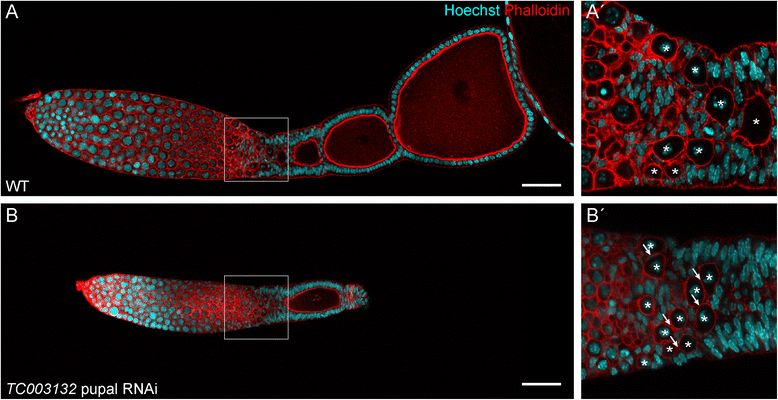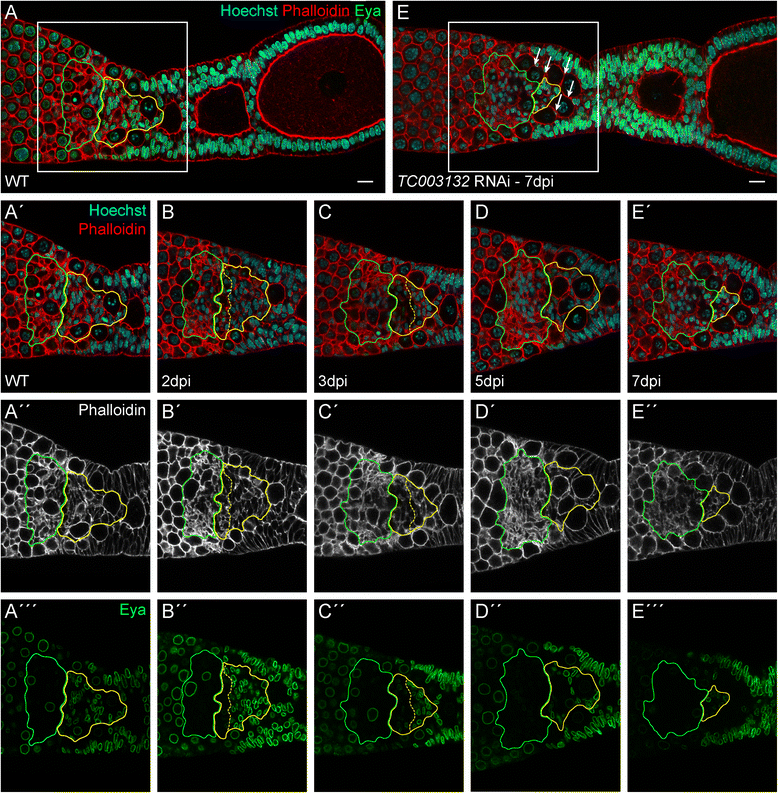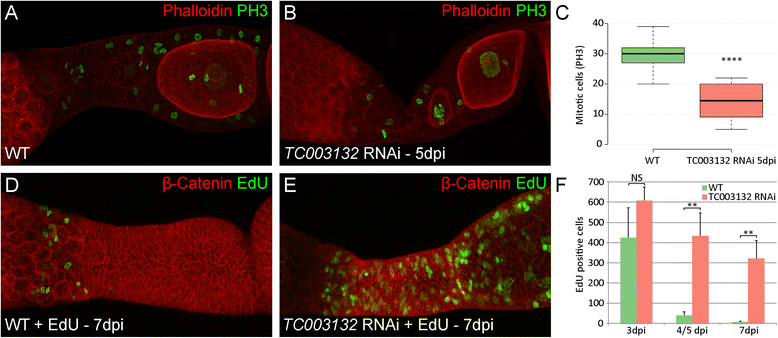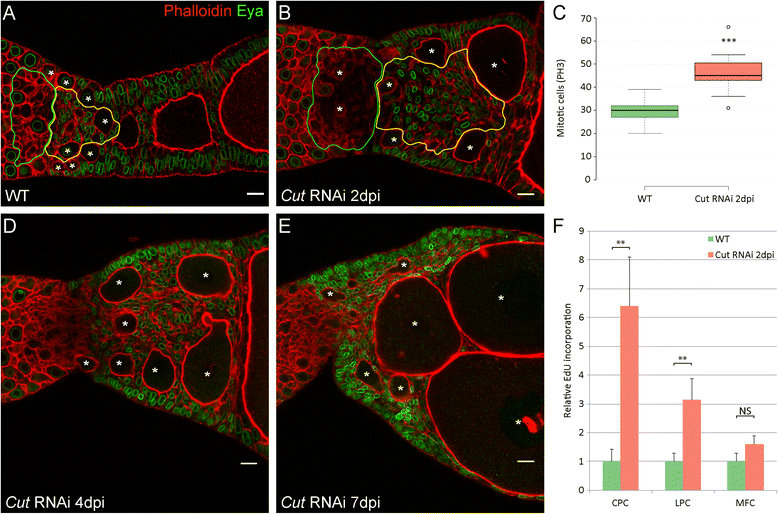TC003132 is essential for the follicle stem cell lineage in telotrophic Tribolium oogenesis
- PMID: 28533810
- PMCID: PMC5438533
- DOI: 10.1186/s12983-017-0212-2
TC003132 is essential for the follicle stem cell lineage in telotrophic Tribolium oogenesis
Abstract
Background: Stem cells are undifferentiated cells with a potential for self-renewal, which are essential to support normal development and homeostasis. To gain insight into the molecular mechanisms underlying adult stem cell biology and organ evolution, we use the telotrophic ovary of the beetle Tribolium. To this end, we participated in a large-scale RNAi screen in the red flour beetle Tribolium, which identified functions in embryonic and postembryonic development for more than half of the Tribolium genes.
Results: We identified TC003132 as candidate gene for the follicle stem cell linage in telotrophic Tribolium oogenesis. TC003132 belongs to the Casein Kinase 2 substrate family (CK2S), which in humans is associated with the proliferative activity of different cancers. Upon TC003132 RNAi, central pre-follicular cells are lost, which results in termination of oogenesis. Given that also Notch-signalling is required to promote the mitotic activity of central pre-follicular cells, we performed epistasis experiments with Notch and cut. In addition, we identified a putative follicle stem cell population by monitoring the mitotic pattern of wild type and TC003132 depleted follicle cells by EdU incorporations. In TC003132 RNAi these putative FSCs cease the expression of differentiation makers and are eventually lost.
Conclusions: TC003132 depleted pre-follicular cells neither react to mitosis or endocycle stimulating signals, suggesting that TC003132 provides competence for differentiation cues. This may resemble the situation in C. elegans were CK2 is required to maintain the balance between proliferation and differentiation in the germ line. Since the earliest effect of TC003132 RNAi is characterized by the loss of putative FSCs, we posit that TC003132 crucially contributes to the proliferation or maintenance of follicle stem cells in the telotrophic Tribolium ovary.
Keywords: Notch-signalling; Tribolium; follicle stem cells; iBeetle; large-scale RNAi screen; telotrophic oogenesis.
Figures








Similar articles
-
Opposing effects of Notch-signaling in maintaining the proliferative state of follicle cells in the telotrophic ovary of the beetle Tribolium.Front Zool. 2012 Aug 6;9(1):15. doi: 10.1186/1742-9994-9-15. Front Zool. 2012. PMID: 22866820 Free PMC article.
-
JAK-STAT signalling is required throughout telotrophic oogenesis and short-germ embryogenesis of the beetle Tribolium.Dev Biol. 2011 Feb 1;350(1):169-82. doi: 10.1016/j.ydbio.2010.10.020. Epub 2010 Oct 23. Dev Biol. 2011. PMID: 20974121
-
iBeetle-Base: a database for RNAi phenotypes in the red flour beetle Tribolium castaneum.Nucleic Acids Res. 2015 Jan;43(Database issue):D720-5. doi: 10.1093/nar/gku1054. Epub 2014 Nov 5. Nucleic Acids Res. 2015. PMID: 25378303 Free PMC article.
-
An update on ecdysone signaling during insect oogenesis.Curr Opin Insect Sci. 2019 Feb;31:8-13. doi: 10.1016/j.cois.2018.07.003. Epub 2018 Jul 10. Curr Opin Insect Sci. 2019. PMID: 31109678 Review.
-
Ovarian stem cell niche and follicular renewal in mammals.Anat Rec (Hoboken). 2011 Aug;294(8):1284-306. doi: 10.1002/ar.21422. Epub 2011 Jun 28. Anat Rec (Hoboken). 2011. PMID: 21714105 Review.
Cited by
-
Expanded and updated data and a query pipeline for iBeetle-Base.Nucleic Acids Res. 2018 Jan 4;46(D1):D831-D835. doi: 10.1093/nar/gkx984. Nucleic Acids Res. 2018. PMID: 29069517 Free PMC article.
-
Notch Signaling in Insect Development: A Simple Pathway with Diverse Functions.Int J Mol Sci. 2023 Sep 13;24(18):14028. doi: 10.3390/ijms241814028. Int J Mol Sci. 2023. PMID: 37762331 Free PMC article. Review.
-
Rational engineering of a synthetic insect-bacterial mutualism.Curr Biol. 2022 Sep 26;32(18):3925-3938.e6. doi: 10.1016/j.cub.2022.07.036. Epub 2022 Aug 12. Curr Biol. 2022. PMID: 35963240 Free PMC article.
-
The red flour beetle T. castaneum: elaborate genetic toolkit and unbiased large scale RNAi screening to study insect biology and evolution.Evodevo. 2022 Jul 19;13(1):14. doi: 10.1186/s13227-022-00201-9. Evodevo. 2022. PMID: 35854352 Free PMC article. Review.
-
Screens in fly and beetle reveal vastly divergent gene sets required for developmental processes.BMC Biol. 2022 Feb 8;20(1):38. doi: 10.1186/s12915-022-01231-4. BMC Biol. 2022. PMID: 35135533 Free PMC article.
References
-
- Margolis J, Spradling A. Identification and behavior of epithelial stem cells in the Drosophila ovary. Development. 1995;121:3797–3807. - PubMed
LinkOut - more resources
Full Text Sources
Other Literature Sources

